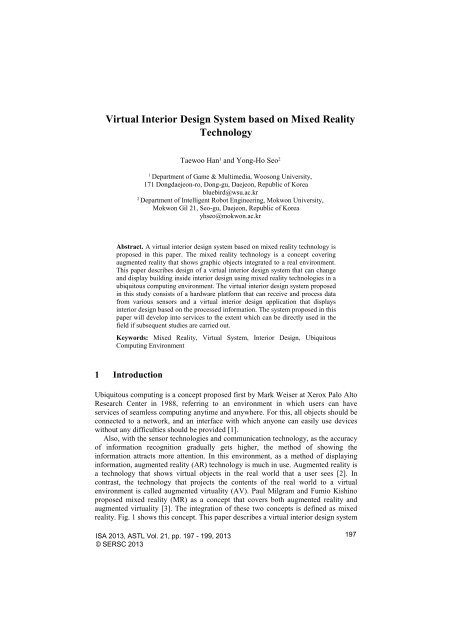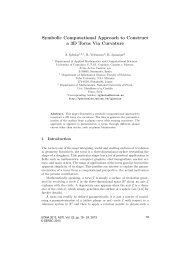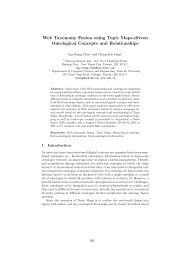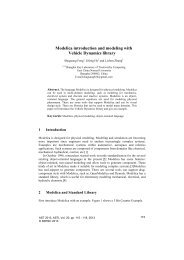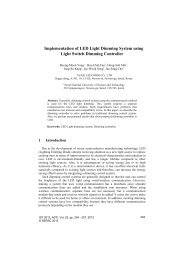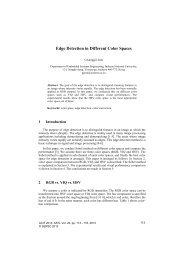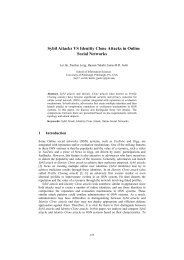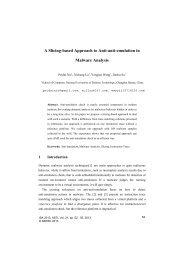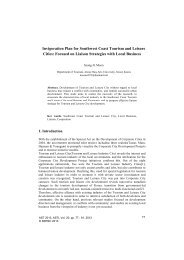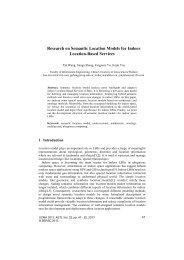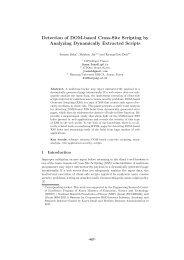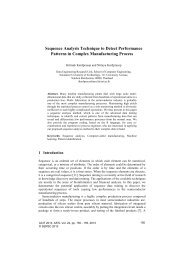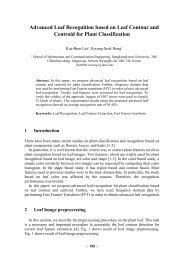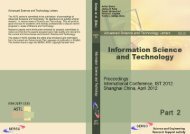Virtual Interior Design System based on Mixed Reality Technology
Virtual Interior Design System based on Mixed Reality Technology
Virtual Interior Design System based on Mixed Reality Technology
You also want an ePaper? Increase the reach of your titles
YUMPU automatically turns print PDFs into web optimized ePapers that Google loves.
<str<strong>on</strong>g>Virtual</str<strong>on</strong>g> <str<strong>on</strong>g>Interior</str<strong>on</strong>g> <str<strong>on</strong>g>Design</str<strong>on</strong>g> <str<strong>on</strong>g>System</str<strong>on</strong>g> <str<strong>on</strong>g>based</str<strong>on</strong>g> <strong>on</strong> <strong>Mixed</strong> <strong>Reality</strong><br />
<strong>Technology</strong><br />
Taewoo Han 1 and Y<strong>on</strong>g-Ho Seo 2<br />
1<br />
Department of Game & Multimedia, Woos<strong>on</strong>g University,<br />
171 D<strong>on</strong>gdaeje<strong>on</strong>-ro, D<strong>on</strong>g-gu, Daeje<strong>on</strong>, Republic of Korea<br />
bluebird@wsu.ac.kr<br />
2<br />
Department of Intelligent Robot Engineering, Mokw<strong>on</strong> University,<br />
Mokw<strong>on</strong> Gil 21, Seo-gu, Daeje<strong>on</strong>, Republic of Korea<br />
yhseo@mokw<strong>on</strong>.ac.kr<br />
Abstract. A virtual interior design system <str<strong>on</strong>g>based</str<strong>on</strong>g> <strong>on</strong> mixed reality technology is<br />
proposed in this paper. The mixed reality technology is a c<strong>on</strong>cept covering<br />
augmented reality that shows graphic objects integrated to a real envir<strong>on</strong>ment.<br />
This paper describes design of a virtual interior design system that can change<br />
and display building inside interior design using mixed reality technologies in a<br />
ubiquitous computing envir<strong>on</strong>ment. The virtual interior design system proposed<br />
in this study c<strong>on</strong>sists of a hardware platform that can receive and process data<br />
from various sensors and a virtual interior design applicati<strong>on</strong> that displays<br />
interior design <str<strong>on</strong>g>based</str<strong>on</strong>g> <strong>on</strong> the processed informati<strong>on</strong>. The system proposed in this<br />
paper will develop into services to the extent which can be directly used in the<br />
field if subsequent studies are carried out.<br />
Keywords: <strong>Mixed</strong> <strong>Reality</strong>, <str<strong>on</strong>g>Virtual</str<strong>on</strong>g> <str<strong>on</strong>g>System</str<strong>on</strong>g>, <str<strong>on</strong>g>Interior</str<strong>on</strong>g> <str<strong>on</strong>g>Design</str<strong>on</strong>g>, Ubiquitous<br />
Computing Envir<strong>on</strong>ment<br />
1 Introducti<strong>on</strong><br />
Ubiquitous computing is a c<strong>on</strong>cept proposed first by Mark Weiser at Xerox Palo Alto<br />
Research Center in 1988, referring to an envir<strong>on</strong>ment in which users can have<br />
services of seamless computing anytime and anywhere. For this, all objects should be<br />
c<strong>on</strong>nected to a network, and an interface with which any<strong>on</strong>e can easily use devices<br />
without any difficulties should be provided [1].<br />
Also, with the sensor technologies and communicati<strong>on</strong> technology, as the accuracy<br />
of informati<strong>on</strong> recogniti<strong>on</strong> gradually gets higher, the method of showing the<br />
informati<strong>on</strong> attracts more attenti<strong>on</strong>. In this envir<strong>on</strong>ment, as a method of displaying<br />
informati<strong>on</strong>, augmented reality (AR) technology is much in use. Augmented reality is<br />
a technology that shows virtual objects in the real world that a user sees [2]. In<br />
c<strong>on</strong>trast, the technology that projects the c<strong>on</strong>tents of the real world to a virtual<br />
envir<strong>on</strong>ment is called augmented virtuality (AV). Paul Milgram and Fumio Kishino<br />
proposed mixed reality (MR) as a c<strong>on</strong>cept that covers both augmented reality and<br />
augmented virtuality [3]. The integrati<strong>on</strong> of these two c<strong>on</strong>cepts is defined as mixed<br />
reality. Fig. 1 shows this c<strong>on</strong>cept. This paper describes a virtual interior design system<br />
ISA 2013, ASTL Vol. 21, pp. 197 - 199, 2013<br />
© SERSC 2013<br />
197
Proceedings, The 7th Internati<strong>on</strong>al C<strong>on</strong>ference <strong>on</strong> Informati<strong>on</strong> Security and Assurance<br />
in which users can change and view building inside interior design using mixed<br />
reality technologies in ubiquitous computing envir<strong>on</strong>ment.<br />
Fig. 1. <strong>Mixed</strong> <strong>Reality</strong> Spectrum<br />
2 Hardware of <str<strong>on</strong>g>Virtual</str<strong>on</strong>g> <str<strong>on</strong>g>Interior</str<strong>on</strong>g> <str<strong>on</strong>g>Design</str<strong>on</strong>g> <str<strong>on</strong>g>System</str<strong>on</strong>g><br />
GPS Global Positi<strong>on</strong>ing <str<strong>on</strong>g>System</str<strong>on</strong>g> is used sometimes instead of markers. However, GPS<br />
was manufactured for outdoors, it is inappropriate to use it in an interior envir<strong>on</strong>ment.<br />
This paper measures the distance to the terminal using terrestrial magnetism sensors<br />
and supers<strong>on</strong>ic sensors, <str<strong>on</strong>g>based</str<strong>on</strong>g> <strong>on</strong> which it describes the method of registering actual<br />
envir<strong>on</strong>ment and virtual objects. And to change interior design in the actual<br />
envir<strong>on</strong>ment, it describes interior design applicati<strong>on</strong>s that can change wallpaper<br />
materials, lighting and visual points, etc. The existing virtual interior design systems<br />
have not been used in interior design with important sense of realism as they used<br />
three-dimensi<strong>on</strong>al graphic spaces <strong>on</strong>ly, so did not reduce the gap with the reality. Also,<br />
in apartment model houses or exhibiti<strong>on</strong> spaces for remodeling, by providing <strong>on</strong>ly <strong>on</strong>e<br />
kind of interior design in <strong>on</strong>e place, various interior designs have not been provided in<br />
interior design services. The virtual interior design system described in this paper<br />
supplements these weaknesses using mixed reality.<br />
The virtual interior design system in this study is to allow users to simulate<br />
drawing interior designs and changing various envir<strong>on</strong>mental factors immediately at<br />
the sites with <strong>on</strong>e smart terminal without needing another device. <str<strong>on</strong>g>Interior</str<strong>on</strong>g> design<br />
businesses can provide clients limitless interior design factors such as wallpaper, tile,<br />
windows and furniture, etc. and the clients of interior design can simulate various<br />
interior designs in advance, so their satisfacti<strong>on</strong> can be promoted after the completi<strong>on</strong><br />
The hardware system grasps the positi<strong>on</strong>, directi<strong>on</strong> and accelerati<strong>on</strong> of a smart<br />
terminal provided with services. Recent smart terminals are equipped with a terrestrial<br />
magnetism sensor that finds directi<strong>on</strong>s and an accelerati<strong>on</strong> sensor that finds the<br />
positi<strong>on</strong> and accelerati<strong>on</strong> of the terminals. So, through these sensors, accurate<br />
informati<strong>on</strong> from the camera built in the smart terminal is obtained and positi<strong>on</strong>ed to<br />
the same space as the objects in the three-dimensi<strong>on</strong>al virtual space to match the<br />
three-dimensi<strong>on</strong>al virtual space with the actual space. To realize the best sense of<br />
reality and service various interior designs, it is essential to obtain the accurate<br />
positi<strong>on</strong> informati<strong>on</strong> of the camera.<br />
However, since general ph<strong>on</strong>es do not have a built-in sensor that can measure<br />
distances, this paper designs and uses an embedded system. In designing the<br />
embedded system, am<strong>on</strong>g AVR family of ATMEL Company, AVR ATmeda128 [4]<br />
that is often used for practices in the field with the highest performance was used.<br />
Al<strong>on</strong>g with this micro c<strong>on</strong>troller, supers<strong>on</strong>ic sensors, accelerati<strong>on</strong> sensors and<br />
terrestrial magnetism sensors are used and through an analog digital c<strong>on</strong>verter (ADC),<br />
data were obtained.<br />
198
<str<strong>on</strong>g>Virtual</str<strong>on</strong>g> <str<strong>on</strong>g>Interior</str<strong>on</strong>g> <str<strong>on</strong>g>Design</str<strong>on</strong>g> <str<strong>on</strong>g>System</str<strong>on</strong>g> <str<strong>on</strong>g>based</str<strong>on</strong>g> <strong>on</strong> <strong>Mixed</strong> <strong>Reality</strong> <strong>Technology</strong><br />
3 <str<strong>on</strong>g>Virtual</str<strong>on</strong>g> <str<strong>on</strong>g>Interior</str<strong>on</strong>g> <str<strong>on</strong>g>Design</str<strong>on</strong>g> Applicati<strong>on</strong> <str<strong>on</strong>g>System</str<strong>on</strong>g><br />
If the actual camera’s three-dimensi<strong>on</strong>al positi<strong>on</strong> coordinate and slope, directi<strong>on</strong> and<br />
screen informati<strong>on</strong> are found through the hardware system, an applicati<strong>on</strong> that can<br />
display building inside interior design using this informati<strong>on</strong> is necessary. Since in<br />
this paper, the virtual interior design applicati<strong>on</strong> uses sensor data in the ubiquitous<br />
computing envir<strong>on</strong>ment in which these functi<strong>on</strong>s are carried out, this is called u-<br />
interior design applicati<strong>on</strong>. The following Fig. 2 shows the screen of the applicati<strong>on</strong>.<br />
Fig. 2. The screen of the applicati<strong>on</strong><br />
4 C<strong>on</strong>clusi<strong>on</strong><br />
With the development of mixed reality technologies, new services emerge in<br />
ubiquitous envir<strong>on</strong>ments. This study implemented a system that can display and<br />
check interior designs in the ubiquitous envir<strong>on</strong>ment using the mixed reality<br />
technology. In the mixed reality, the problem of registering actual space and virtual<br />
space is very important, and this paper used supers<strong>on</strong>ic sensors, terrestrial magnetism<br />
sensors and accelerati<strong>on</strong> sensors instead of makers to improve weaknesses of using<br />
them. The proposed mixed reality <str<strong>on</strong>g>based</str<strong>on</strong>g> interior design system in this study will<br />
develop services that can be directly used in the field if subsequent studies are carried<br />
out further, and it is expected that its blending with sensor technology will have a<br />
great potential of development.<br />
References<br />
1. Mark Weiser, The computer for the twenty-first century, Scientific American, pp. 94-104,<br />
September (1991)<br />
2. Azuma, R. T. A Survey of Augmented <strong>Reality</strong>, Presence: Teleoperators and <str<strong>on</strong>g>Virtual</str<strong>on</strong>g><br />
Envir<strong>on</strong>ments, Vol. 6, No. 4, pp. 355-385, August (1997)<br />
3. Milgram, P. and Kishino, F, "A Tax<strong>on</strong>omy of <strong>Mixed</strong> <strong>Reality</strong> Visual Displays", IEICE<br />
Transacti<strong>on</strong>s <strong>on</strong> Informati<strong>on</strong> <str<strong>on</strong>g>System</str<strong>on</strong>g>s, Vol E77-D, No.12, December (1994)<br />
4. S<strong>on</strong>g, B<strong>on</strong>g-Gil, AVR ATmega128 Microc<strong>on</strong>troller using IAR EWAVR Compiler. pp. 15-<br />
18, Se<strong>on</strong>gandang (2008)<br />
199


